Influence of Concrete Shrinkage on the Behavior of Carbon Short-Fiber-Reinforced Concrete (CSFRC) under Tension
Abstract
1. Introduction
2. Materials and Methods
2.1. Raw Materials and Mixing Procedure
2.2. Printing Process and Curing Procedure
2.3. Testing Procedure
3. Results
3.1. Tensile Strength, Stress Causing First Crack Appearance, and Ultimate Tensile Strain
- —tensile strength of CSFRC at the age ();
- —tensile strength of CSFRC at the age of 28 days;
- —tensile strength of CSFRC at the age of 21 days.
3.2. Elasticity Modulus
3.3. Stress–Strain Curve
- The growing up period or “childhood”;
- Maturity or “the best period of life”;
- The “old age period”.
3.4. Concrete Shrinkage Influence on the CSFRC Behavior
3.5. Digital Image Correlation (DIC)
4. Conclusions
- The hardening process is faster for CSFRC than normal concrete or UHPC, and CSFRC reaches full tensile strength at the age of 21 days.
- Reinforcing concrete with carbon fibers contributes to the increase in elasticity modulus and prolongs the time of its development up to 21 days of age. Carbon fibers also prevent subsequent degradation of the elasticity modulus, e.g., between the 21st and 91st day of age.
- The temporal development of CSFRC tensile strength, first crack strength, ultimate tensile strain, and elasticity modulus can be well estimated using the modified fib Model Code 2010 equations proposed in this work.
- The tensile behavior of CSFRC significantly differs from that of unreinforced concrete, showing similarities with steel behavior. Hence, it can be estimated using a bi-linear diagram through three points, especially in the second life period. However, in the first and third life periods, the bi-linear diagram through three points can underestimate damage in the CSFRC in the region between the stress level of the first nonlinearities and achieving the full tensile strength of CSFRC; hence, in these life periods, the four-point stress–strain curve is proposed as a material model.
- Concrete shrinkage has a significant influence on the CSFRC behavior over time, decreasing the ductility and energy dissipation capacity. In the linear region, it causes faster strain development, while in the nonlinear region, it reduces the damage capacity.
- Concrete shrinkage can also have a positive influence on CSFRC behavior, contributing to increased tensile strength and first crack strength in “life periods” 2 and 3.
Author Contributions
Funding
Institutional Review Board Statement
Informed Consent Statement
Data Availability Statement
Acknowledgments
Conflicts of Interest
References
- Hamad, H.M.; Shi, J.; Al Jawahery, M.S.; Majdi, A.; Yousif, S.T.; Kaplan, G. Application of natural fibers in cement concrete: A critical review. Mater. Today Commun. 2023, 35, 105833. [Google Scholar] [CrossRef]
- Ahmad Firas, S.; Gilles, F.; Le Roy, R. Bond between carbon fiber-reinforced polymer (CFRP) bars and ultra high performance fiber reinforced concrete (UHPFRC): Experimental study. Constr. Build. Mater. 2011, 25, 479–485. [Google Scholar] [CrossRef]
- Serdar Camli, U.; Binici, B. Strength of carbon fiber reinforced polymers bonded to concrete and masonry. Constr. Build. Mater. 2007, 21, 1431–1446. [Google Scholar] [CrossRef]
- Li, R.; Sang Cho, Y.; Zhang, S. Punching shear behavior of concrete flat plate slab reinforced with carbon fiber reinforced polymer rods. Compos. B Eng. 2007, 38, 712–719. [Google Scholar] [CrossRef]
- Calvet, V.; Valcuende, M.; Benlloch, J.; Canoves, J. Influence of moderate temperatures on the bond between carbon fiber reinforced polymer bars (CFRP) and concrete. Constr. Build. Mater. 2015, 94, 589–604. [Google Scholar] [CrossRef]
- Jing, M.; Grünberg, G. Mechanical analysis of reinforced concrete box beam strengthened with carbon fiber sheets under combined actions. Compos. Struct. 2006, 73, 488–494. [Google Scholar] [CrossRef]
- Jing, M.; Raongjant, W.; Li, Z. Torsional strengthening of reinforced concrete box beams using carbon fiber reinforced polymer. Compos. Struct. 2007, 78, 264–270. [Google Scholar] [CrossRef]
- Lee, W.T.; Chiou, Y.J.; Shih, M.H. Reinforced concrete beam-column joint strengthened with carbon fiber reinforced polymer. Compos. Struct. 2010, 92, 48–60. [Google Scholar] [CrossRef]
- Lee, H.S.; Kage, T.; Noguchi, T.; Tomosawa, F. An experimental study on the fetrofitting effects of reinforced concrete columns damaged by rebar corrosion strengthened with carbon fiber sheets. Cem. Concr. Res. 2003, 33, 563–570. [Google Scholar] [CrossRef]
- Piekarczyk, J.; Piekarczyk, W.; Blazewicz, S. Compression strength of concrete cylinders reinforced with carbon fiber laminate. Constr. Build. Mater. 2011, 25, 2365–2369. [Google Scholar] [CrossRef]
- Hambach, M.; Möller, H.; Neumann, T.; Volkmer, D. Portland cement paste with aligned carbon fibers exhibiting exceptionally high flexural strength (>100 MPa). Cem. Concr. Res. 2016, 89, 80–86. [Google Scholar] [CrossRef]
- Lauff, P.; Pugacheva, P.; Rutzen, M.; Weiß, U.; Fischer, O.; Volkmer, D.; Peter, M.A.; Große, C.U. Evaluation of the Behavior of Carbon Short Fiber Reinforced Concrete (CSFRC) Based on a Multi-Sensory Experimental investigation and a Numerical Multiscale Approach. Materials 2021, 14, 7005. [Google Scholar] [CrossRef] [PubMed]
- Rutzen, M.; Lauff, P.; Niedermeier, R.; Fischer, O.; Raith, M.; Grosse, C.U.; Weiss, U.; Peter, M.A.; Volkmer, D. Influence of fiber alignment on pseudoductility and microcracking in a cementitious carbon fiber composite material. Mater. Struct. 2021, 54, 58. [Google Scholar] [CrossRef]
- Rutzen, M.; Schulz, M.; Mossburger-Will, J.; Lauff, P.; Fischer, O.; Volkmer, D. 3D printing as an automated manufacturing method for a carbon fiber-reinforced cementitious composite with outstanding flexural strength (105 N/mm2). Mater. Struct. 2021, 54, 234. [Google Scholar] [CrossRef]
- Nerella, V.N.; Ogura, H.; Mechtcherine, V. Incorporating reinforcement into digital concrete construction. In Proceedings of the IASS Symposium 2018: Creativity in Structural Design, Boston, MA, USA, 16–20 July 2018. [Google Scholar]
- Ivorra, S.; Garces, P.; Catala, G.; Andion, L.G.; Zornoza, E. Effect of silica fume particle size on mechanical properties of short carbon fiber reinforced concrete. Mater. Des. 2010, 31, 1553–1558. [Google Scholar] [CrossRef]
- Chen, P.W.; Chung, D.D.L. Low-drying-shrinkage concrete containing carbon fibers. Compos. B Eng. 1996, 27B, 269–274. [Google Scholar] [CrossRef]
- Lura, P.; Jensen, O.M.; van Breugel, K. Autogenous shrinkage in high-performance cement paste: An evaluation of basic mechanisms. Cem. Concr. Res. 2003, 33, 223–232. [Google Scholar] [CrossRef]
- Wu, L.; Farzadnia, N.; Shi, C.; Zhang, Z.; Wang, H. Autogenous shrinkage of high performance concrete: A review. Constr. Build. Mater. 2017, 149, 62–75. [Google Scholar] [CrossRef]
- Yang, L.; Shi, C.; Wu, Z. Mitigation techniques for autogenous shrinkage of ultra-high-performance concrete—A review. Compos. B Eng. 2019, 178, 107456. [Google Scholar] [CrossRef]
- Mazoli, A.; Monosi, S.; Plescia, E.S. Evaluation of the early-age-shrinkage of Fiber Reinforced Concrete (FRC) using image analysis methods. Constr. Build. Mater. 2015, 101, 596–601. [Google Scholar] [CrossRef]
- Bontea, D.M.; Chung, D.D.L.; Lee, G.C. Damage in carbon fiber-reinforced concrete, monitored by electrical resistance measurement. Cem. Concr. Res. 2000, 30, 651–659. [Google Scholar] [CrossRef]
- Chen, P.W.; Chung, D.D.L. Carbon fiber reinforced concrete for smart structures capable of non-destructive flaw detection. Smart. Mater. Struct. 1993, 2, 22–30. [Google Scholar] [CrossRef]
- Chen, B.; Liu, J. Damage in carbon fiber-reinforced concrete, monitored by both electrical resistance measurement and acoustic emission analysis. Constr. Build. Mater. 2008, 22, 2196–2201. [Google Scholar] [CrossRef]
- Chung, D.D.L. Cement reinforced with short carbon fibers: A multifunctional material. Compos. B Eng. 2000, 31, 511–526. [Google Scholar] [CrossRef]
- Shi, Z.Q.; Chung, D.D.L. Carbon fiber-reinforced concrete for traffic monitoring and weighing in motion. Cem. Concr. Res. 1999, 29, 435–439. [Google Scholar] [CrossRef]
- Sun, M.; Liu, Q.; Li, Z.; Hu, Y. A study of piezoelectric properties of carbon fiber reinforced concrete and plain cement paste during dynamic loading. Cem. Concr. Res. 2000, 30, 1593–1595. [Google Scholar] [CrossRef]
- Sun, M.; Li, Z.; Mao, Q.; Shen, D. Study on the hole conduction phenomenon in carbon fiber-reinforced concrete. Cem. Concr. Res. 1998, 28, 549–554. [Google Scholar] [CrossRef]
- Sun, M.; Li, Z.; Mao, Q.; Shen, D. Thermoelectric percolation phenomena in carbon fiber-reinforced concrete. Cem. Concr. Res. 1998, 28, 1707–1712. [Google Scholar] [CrossRef]
- Wang, W.; Wu, S.; Dai, H. Fatigue behavior and life prediction of carbon fiber reinforced concrete under cyclic flexural loading. Mater. Sci. Eng. A 2006, 434, 347–351. [Google Scholar] [CrossRef]
- TUMuenchen. 3D Printing in Concrete. Additive Manufacturing at TUM. Available online: https://www.youtube.com/watch?v=H3aD0VZ3ESU (accessed on 17 March 2021).
- Fischer, O.; Volkmer, D.; Lauff, P.; Hambach, M.; Rutzen, M. Zementgebundener Kohlenstofffaserverstärkter Hochleistungswerkstoff (Carbonkurzfaserbeton); Forschungsinitiative Zukunft Bau, Band F 3178; Fraunhofer IRB Verlag: Stuttgart, Germany, 2019. [Google Scholar]
- Lauff, P.; Fischer, O. Effizienter Ultrahochleistungsbeton mit innovativer trajektorienorientierter „Bewehrung“. Ce Pap. 2019, 3, 82–88. [Google Scholar] [CrossRef]
- Oluokun, F.A.; Burdette, E.G.; Deatherage, J.H. Rates of Development of Physical Properties of Concrete at Early Ages. Transp. Res. Rec. 1990, 1284, 16–22. [Google Scholar]
- Obayes, O.; Gad, E.; Pokharel, T.; Lee, J.; Abdouka, K. Evaluation of Concrete Material Properties at Early Age. CivilEng 2020, 1, 326–350. [Google Scholar] [CrossRef]
- International Federation for Structural Concrete (fib). Model Code 2010; International Federation for Structral Concrete: Lausanne, Switzerland, 2010. [Google Scholar]
- Kusumawardaningsih, Y.; Fehling, E.; Ismail, M.; Aboubakr, A.A.M. Tensile strength behaviour of UHPC and UHPFRC. Procedia Eng. 2015, 125, 1081–1086. [Google Scholar] [CrossRef]
- Fladr, J.; Bily, P.; Trtik, T. Analysis of the influence of supplementary cementitious materials used in UHPC on modulus of elasticity. IOP Conf. Ser. Mater. Sci. Eng. 2019, 522, 012010. [Google Scholar] [CrossRef]
- Kocab, D.; Kucharczykova, B.; Misak, P.; Zitt, P.; Kralikova, M. Development of the Elastic Modulus of Concrete under Different Curing Conditions. Procedia Eng. 2017, 195, 96–101. [Google Scholar] [CrossRef]
- Van Breugel, K.; Van Tuan, N. Autogenous Shrinkage of HPC and Ways to Mitigate it. Key Eng. Mater. 2014, 629–630, 3–20. [Google Scholar] [CrossRef]
- Džolan, A.; Galić, M.; Harapin, A. Model for the Simulation of the Time-Dependent State in RC Elements. Appl. Sci. 2022, 12, 1501. [Google Scholar] [CrossRef]
- Džolan, A.; Kožul, M.; Harapin, A.; Ćubela, D. Analysis of the concrete shrinkage effects on the real behavior of the spatial concrete and reinforced concrete structures using the thermal analogy. Eng. Comput. 2020, 37, 1451–1472. [Google Scholar] [CrossRef]
- Gribniak, V.; Kaklauskas, G.; Kliukas, R.; Jakubovskis, R.J. Shrinkage effect on short-term deformation behavior of reinforced concrete—When it should not be neglected. Mater. Des. 2013, 51, 1060–1070. [Google Scholar] [CrossRef]

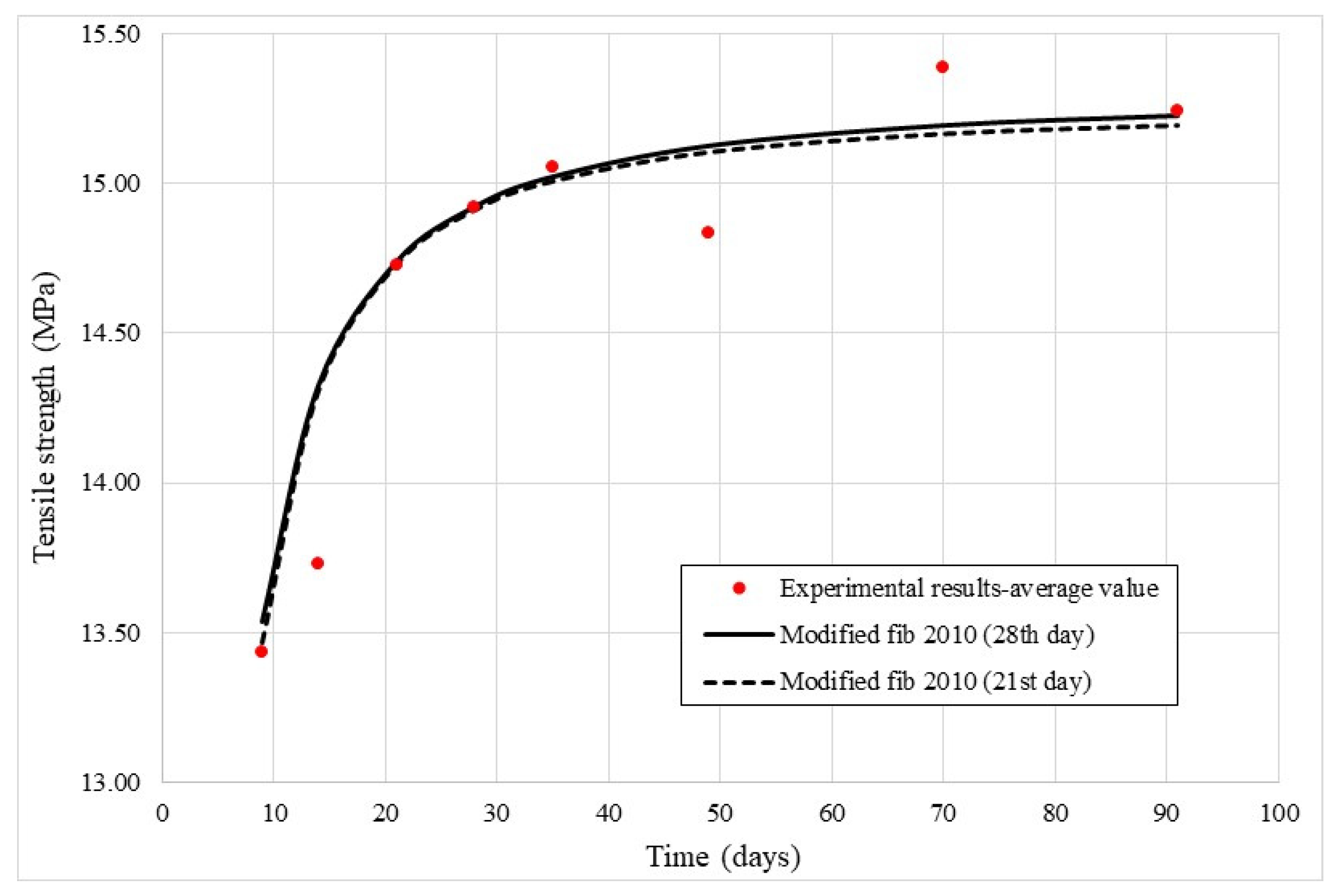
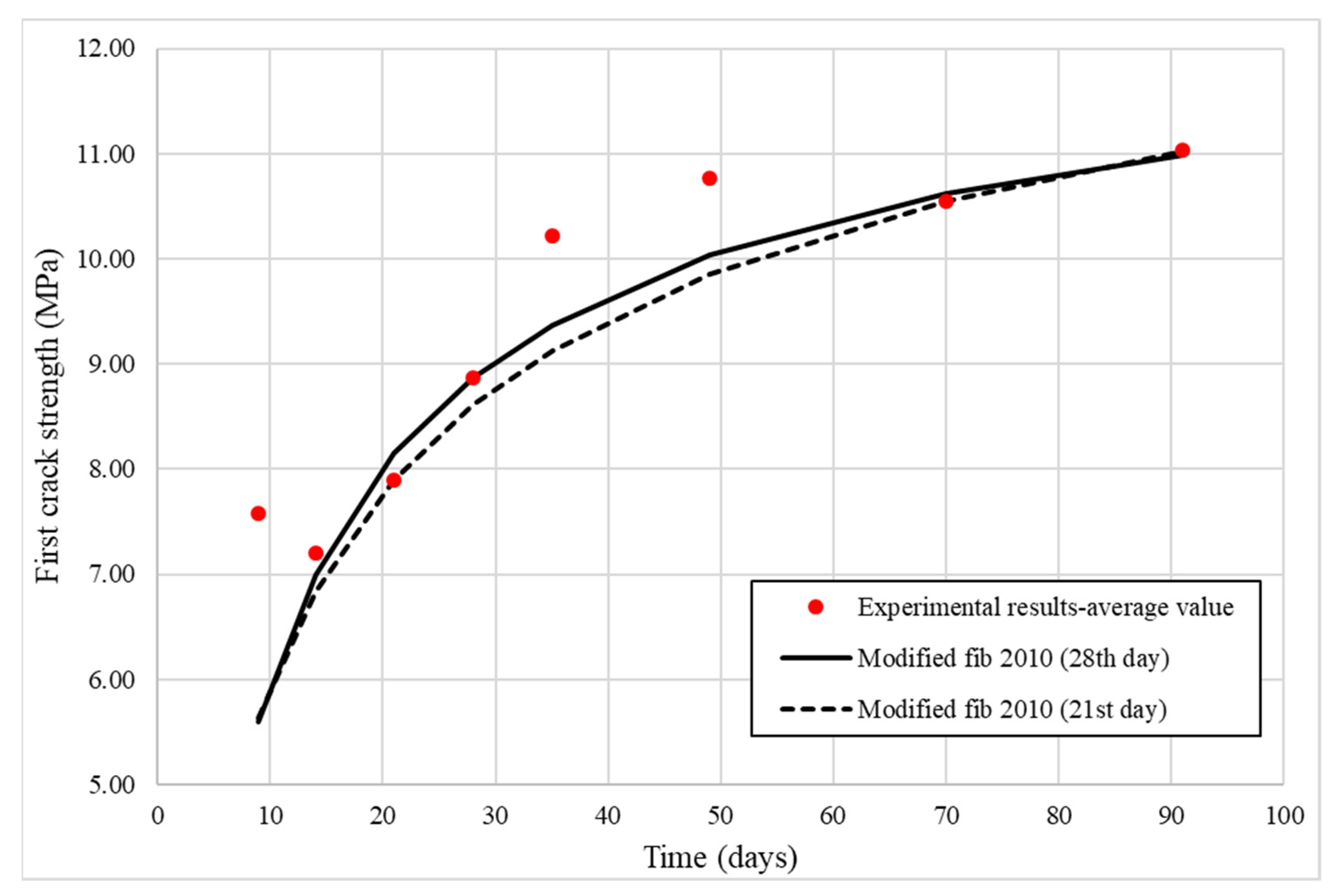
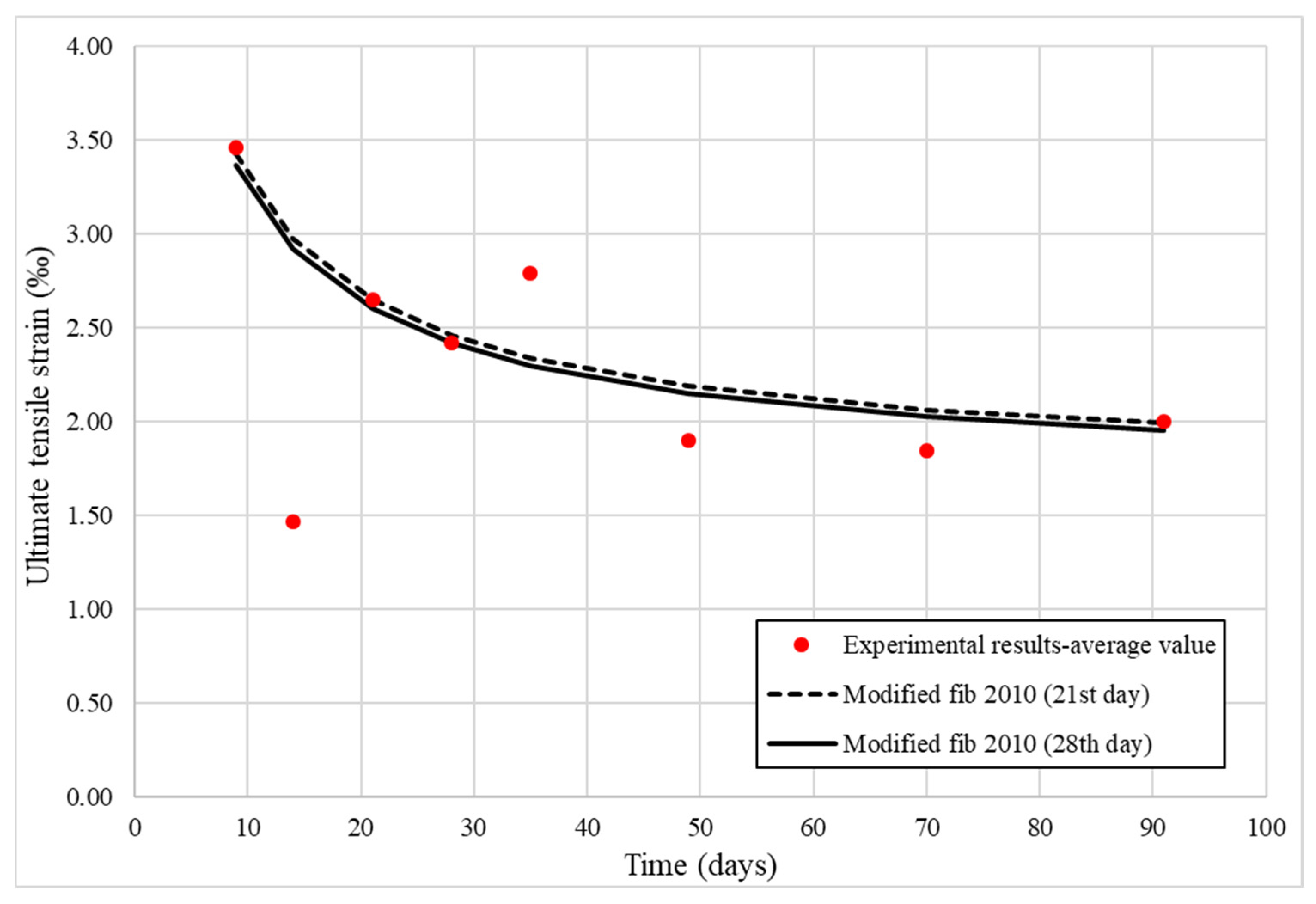
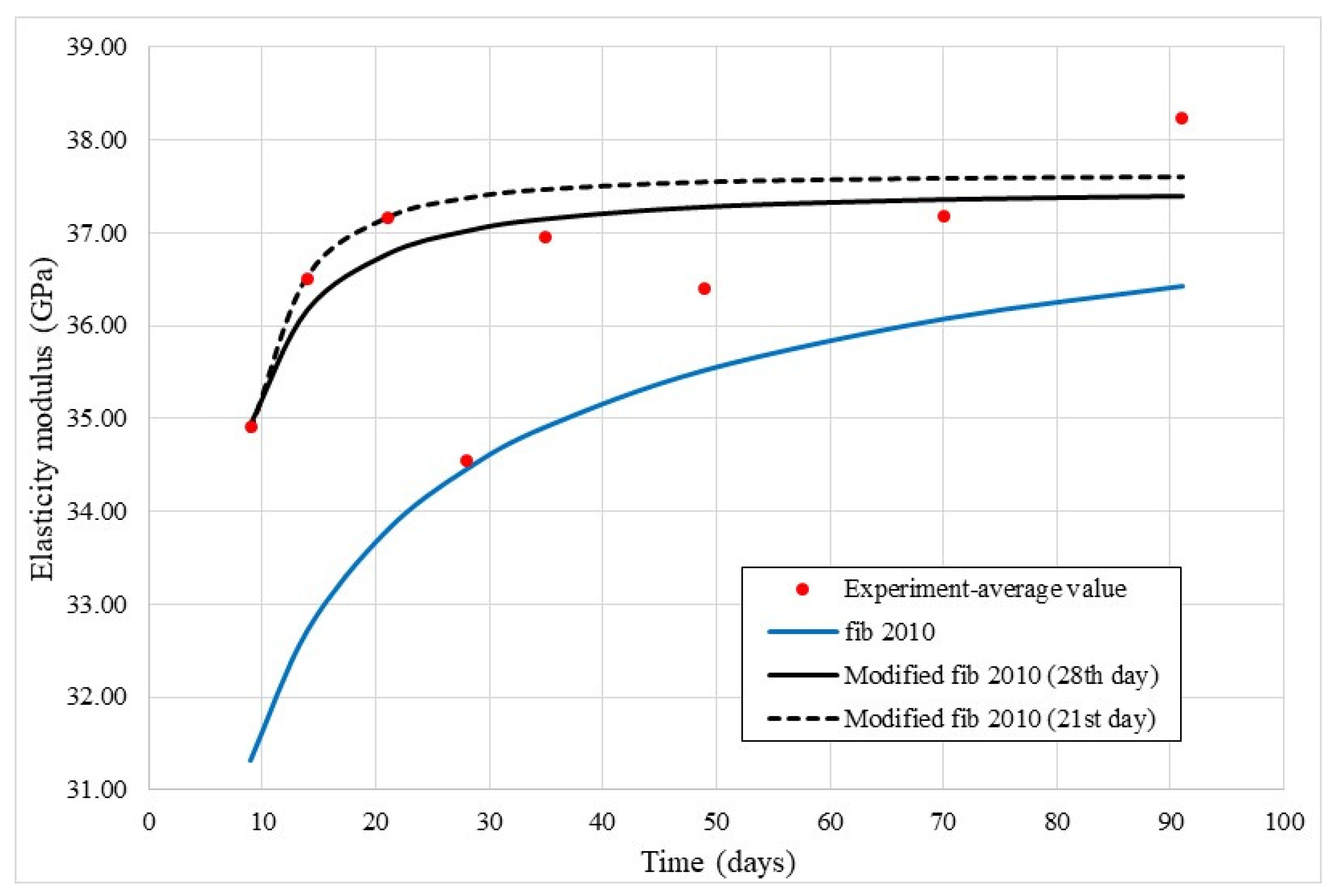
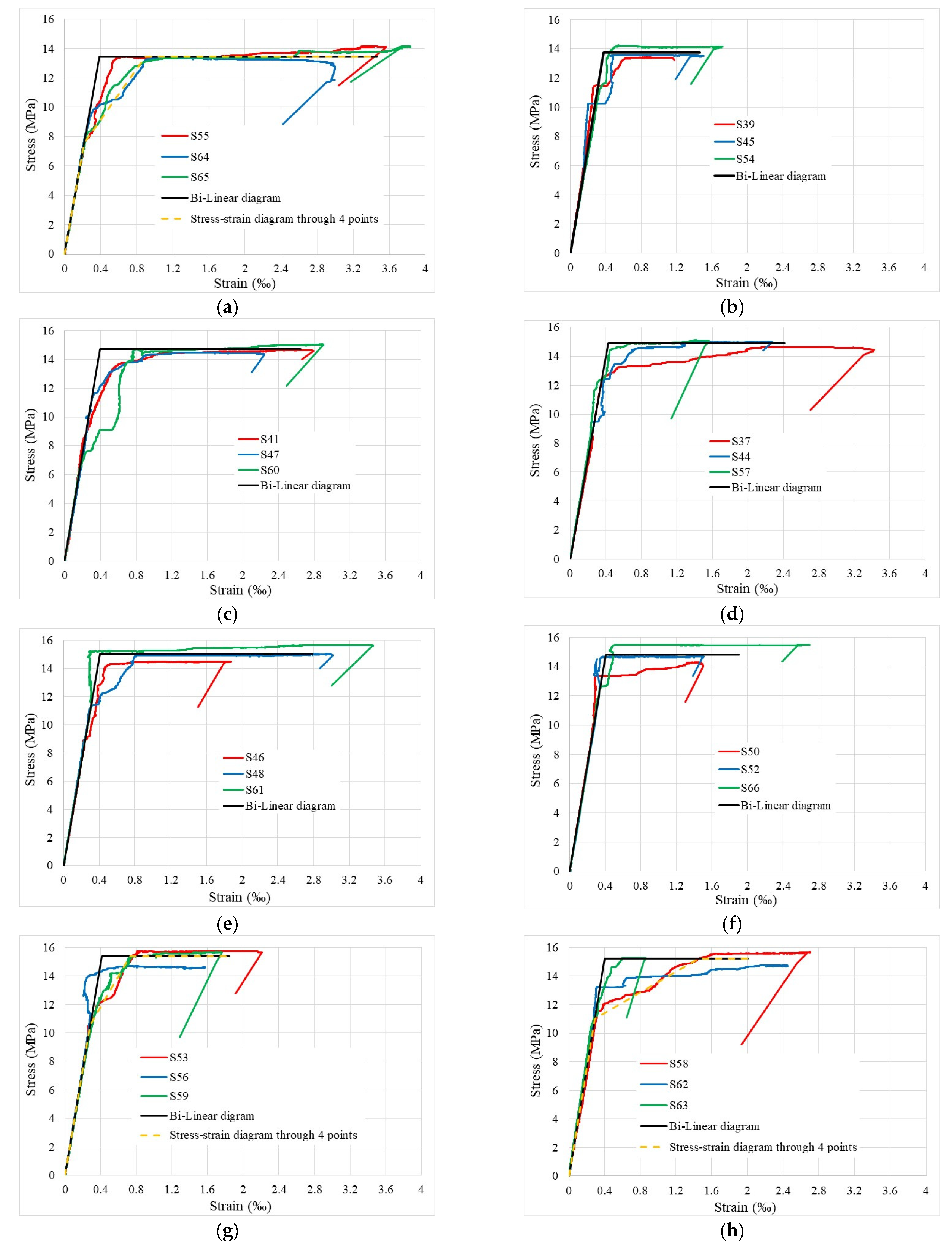



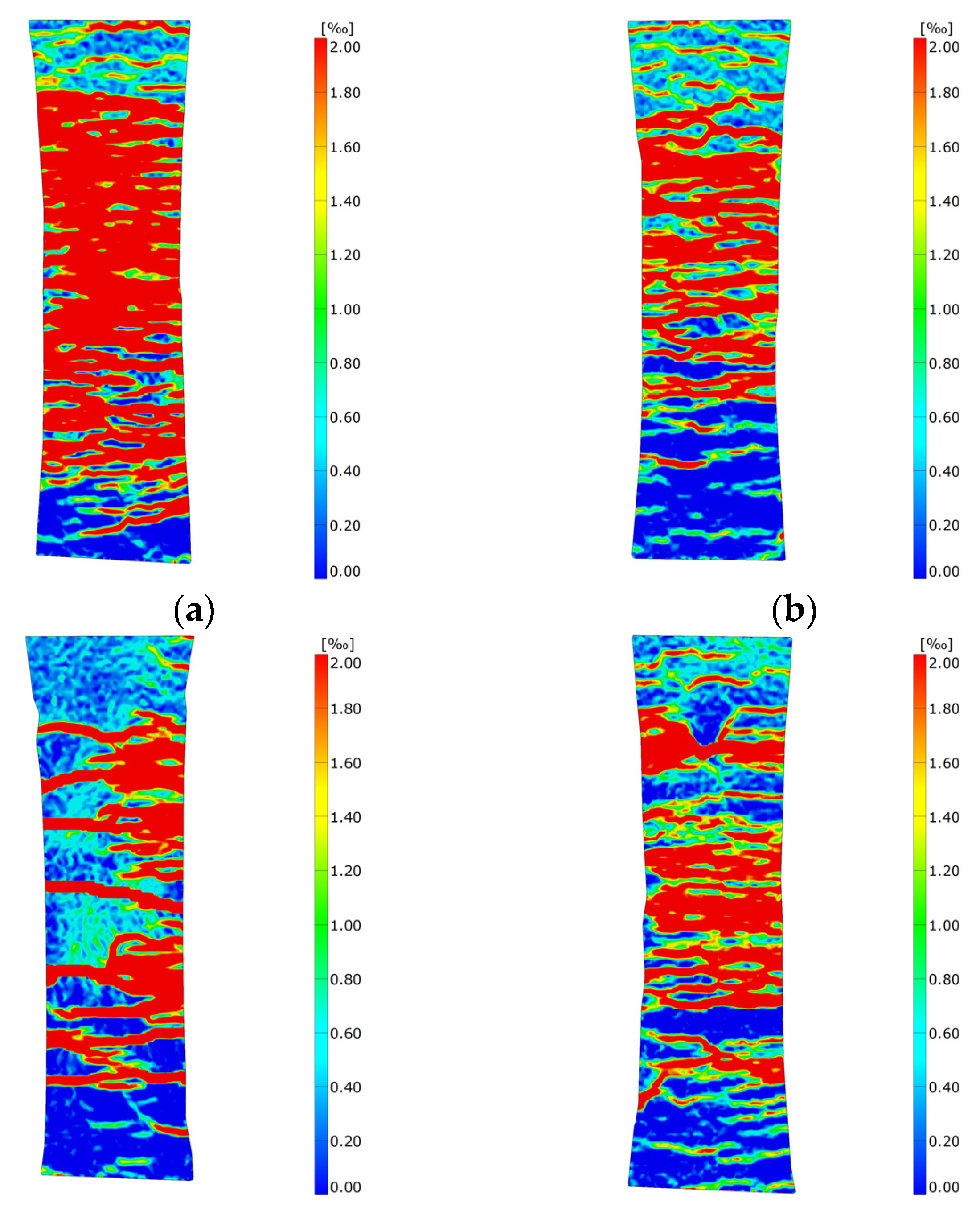
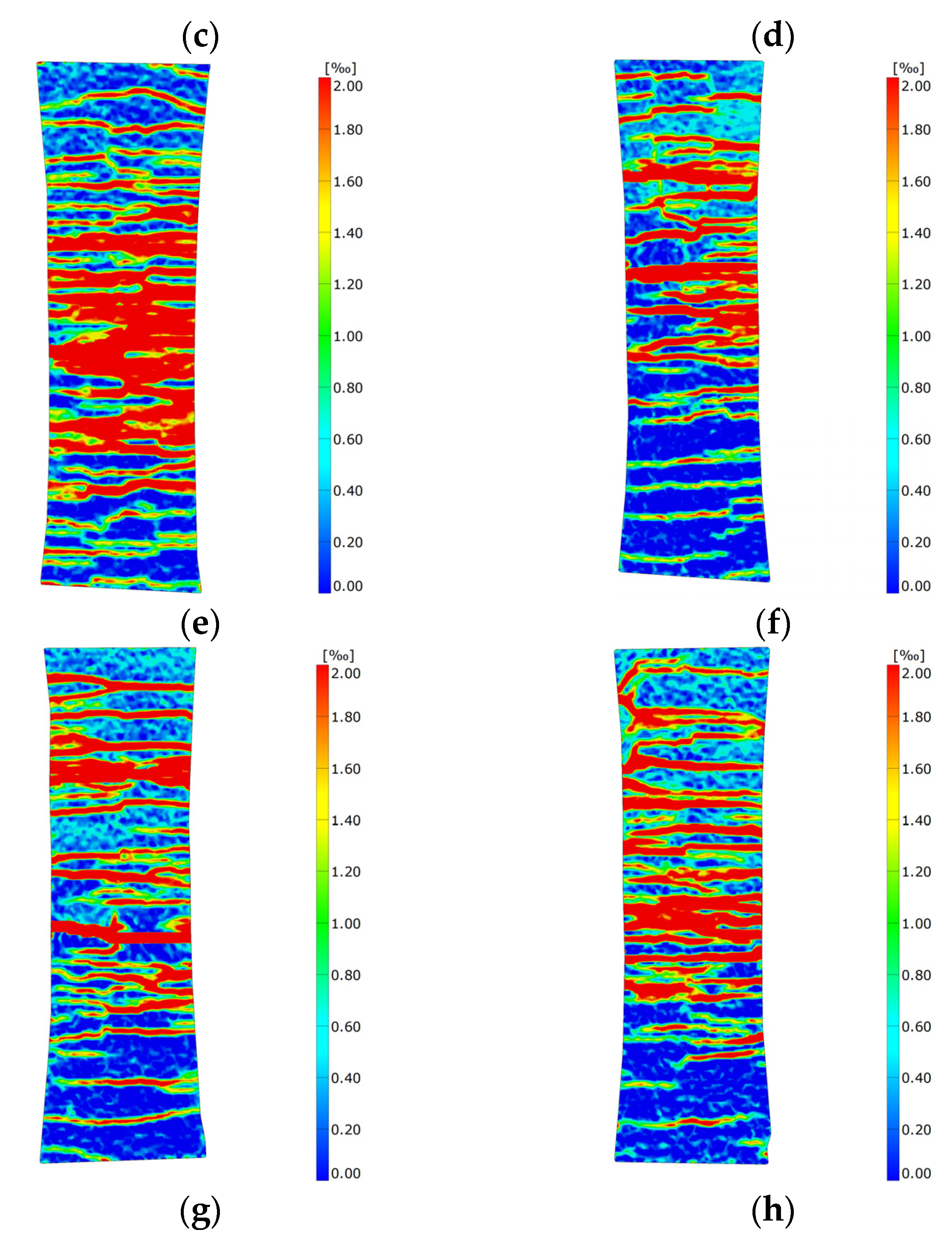
| Component | Type of Component | wt% |
|---|---|---|
| Cement | Holcim Sulfo 52.5 R | 34.70 |
| Silica fume | Sika Silicol P | 21.70 |
| Quartz powder | SF500 | 21.70 |
| Quartz sand | H33 | 7.70 |
| Water | ----- | 11.70 |
| Superplasticizer | BASF ACE 460 | 2.50 |
| Carbon fibers | Zoltek (Toray) PX35, 3 mm | 1.00 (vol%) |
| Specimen Age | Specimen Name | Tensile Strength [MPa] | Average Tensile Strength [MPa] | Elasticity Modulus [GPa] | Average Elasticity Modulus [GPa] |
|---|---|---|---|---|---|
| 9 | S55 | 13.57 | 13.44 | 34.75 | 34.91 |
| S64 | 13.33 | 35.50 | |||
| S65 | 13.41 | 34.48 | |||
| 14 | S39 | 13.42 | 13.73 | 38.60 | 36.50 |
| S45 | 13.57 | 35.30 | |||
| S54 | 14.20 | 35.60 | |||
| 21 | S41 | 14.66 | 14.73 | 36.45 | 37.17 |
| S47 | 14.48 | 36.45 | |||
| S60 | 15.05 | 38.60 | |||
| 28 | S37 | 14.64 | 14.92 | 32.60 | 34.55 |
| S44 | 15.01 | 35.00 | |||
| S57 | 15.11 | 36.05 | |||
| 35 | S46 | 14.47 | 15.06 | 36.20 | 36.95 |
| S48 | 15.03 | 37.70 | |||
| S61 | 15.67 | 36.95 | |||
| 49 | S50 | 14.30 | 14.84 | 37.95 | 36.40 |
| S52 | 14.70 | 35.30 | |||
| S66 | 15.51 | 35.95 | |||
| 70 | S53 | 15.75 | 15.39 | 37.20 | 37.18 |
| S56 | 14.72 | 38.20 | |||
| S59 | 15.69 | 36.15 | |||
| 91 | S58 | 15.68 | 15.24 | 35.00 | 38.23 |
| S62 | 14.77 | 37.70 | |||
| S63 | 15.28 | 42.00 |
| Specimen Age | Specimen Name | First Crack Strength [MPa] | Average First Crack Strength [MPa] | Ultimate Strain [‰] | Average Ultimate Strain [‰] |
|---|---|---|---|---|---|
| 9 | S55 | 7.00 | 7.57 | 3.56 | 3.46 |
| S64 | 8.19 | 3.00 | |||
| S65 | 7.53 | 3.83 | |||
| 14 | S39 | 9.75 | 7.20 | 1.17 | 1.47 |
| S45 | 5.85 | 1.50 | |||
| S54 | 6.00 | 1.73 | |||
| 21 | S41 | 8.40 | 7.90 | 2.80 | 2.65 |
| S47 | 7.80 | 2.25 | |||
| S60 | 7.50 | 2.90 | |||
| 28 | S37 | 8.30 | 8.87 | 3.42 | 2.42 |
| S44 | 9.20 | 2.28 | |||
| S57 | 9.11 | 1.56 | |||
| 35 | S46 | 8.70 | 10.22 | 1.88 | 2.79 |
| S48 | 10.30 | 3.02 | |||
| S61 | 11.65 | 3.47 | |||
| 49 | S50 | 10.25 | 10.77 | 1.50 | 1.90 |
| S52 | 11.90 | 1.50 | |||
| S66 | 10.15 | 2.70 | |||
| 70 | S53 | 10.10 | 10.55 | 2.20 | 1.84 |
| S56 | 11.35 | 1.57 | |||
| S59 | 10.20 | 1.76 | |||
| 91 | S58 | 11.56 | 11.03 | 2.70 | 2.00 |
| S62 | 11.18 | 2.45 | |||
| S63 | 10.35 | 0.86 |
Disclaimer/Publisher’s Note: The statements, opinions and data contained in all publications are solely those of the individual author(s) and contributor(s) and not of MDPI and/or the editor(s). MDPI and/or the editor(s) disclaim responsibility for any injury to people or property resulting from any ideas, methods, instructions or products referred to in the content. |
© 2023 by the authors. Licensee MDPI, Basel, Switzerland. This article is an open access article distributed under the terms and conditions of the Creative Commons Attribution (CC BY) license (https://creativecommons.org/licenses/by/4.0/).
Share and Cite
Džolan, A.; Lauff, P.; Fischer, O.; Šunjić, G. Influence of Concrete Shrinkage on the Behavior of Carbon Short-Fiber-Reinforced Concrete (CSFRC) under Tension. Appl. Sci. 2023, 13, 7081. https://doi.org/10.3390/app13127081
Džolan A, Lauff P, Fischer O, Šunjić G. Influence of Concrete Shrinkage on the Behavior of Carbon Short-Fiber-Reinforced Concrete (CSFRC) under Tension. Applied Sciences. 2023; 13(12):7081. https://doi.org/10.3390/app13127081
Chicago/Turabian StyleDžolan, Ante, Philipp Lauff, Oliver Fischer, and Goran Šunjić. 2023. "Influence of Concrete Shrinkage on the Behavior of Carbon Short-Fiber-Reinforced Concrete (CSFRC) under Tension" Applied Sciences 13, no. 12: 7081. https://doi.org/10.3390/app13127081
APA StyleDžolan, A., Lauff, P., Fischer, O., & Šunjić, G. (2023). Influence of Concrete Shrinkage on the Behavior of Carbon Short-Fiber-Reinforced Concrete (CSFRC) under Tension. Applied Sciences, 13(12), 7081. https://doi.org/10.3390/app13127081






